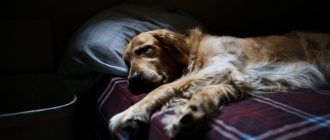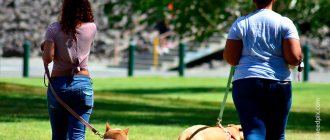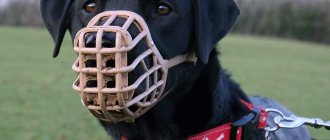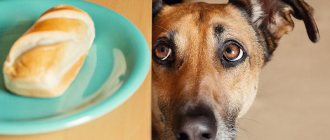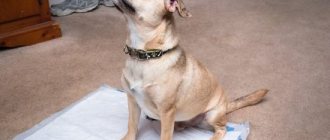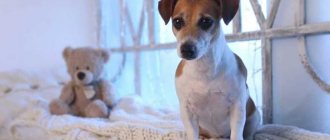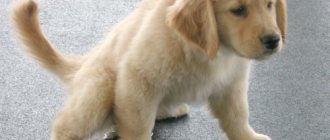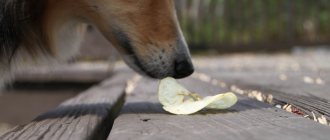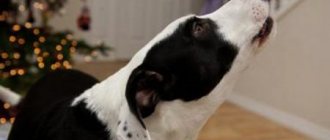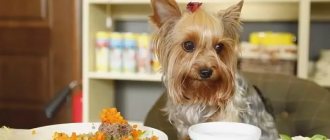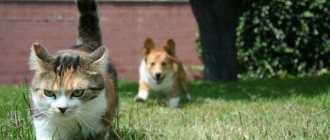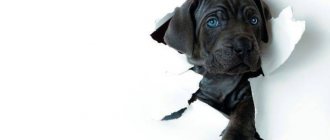The appearance of an animal changes the atmosphere and decor in the house. His clumsy attempts to walk and jump cause affection, but the occasional puddles cause indignation. In the first months of life, this is a normal phenomenon and you will have to make every effort and be patient to potty train your baby. But if this happens systematically or an adult pet suddenly begins to mark its territory, then it is advisable to analyze the situation. Useful advice from breeders and veterinarians will help you stop your dog from crapping in the house at any age.
Why does a puppy pee or shit at home?
To solve the problem, you need to find out the reasons for your dog's bowel movements at home.
First of all, this is due to the age of the animal. If we have a puppy under 4-6 months of age, then the problem is temporary, because he cannot yet control his biological needs. Before vaccination, it is better for a small pet to stay in the apartment so as not to catch the infection on the street. At first, when adapting to a new home, the dog may experience stress: from a change of environment, separation from its mother, or the transition to new types of food. During this period, you should use disposable diapers or highly absorbent newsprint. The owner needs to be affectionate and patient.
After all the vaccinations have been given, you need to gradually accustom the animal to walks and feedings at the same time, and try not to violate the established daily routine. Sometimes it helps to perform motionless commands “sit” or “lie down”; this will distract the pet a little and help him endure the walk.
Day mode
In a puppy under 6 months of age, the bladder muscles are still very weak. They physically cannot endure for long. Therefore, leaving your baby at home all day and scolding him for puddles is not very wise on your part. Before asking when a puppy stops peeing at home, try to think about how much time you are willing to dedicate to raising him. If you are too busy, then do not take on additional responsibility for the life and health of the dog.
Why did an adult dog start peeing or shitting at home?
If the dog is already an adult, then there are many reasons:
- Diseases. Diseases of the digestive and genitourinary systems or helminthic infestations. This also includes old and pregnant animals. All educational measures apply only to healthy individuals, so a trip to the veterinarian is necessary to find out if the pet is sick and to carry out treatment if necessary.
- Features related to gender. For a bitch, problems with the toilet before the age of two are considered acceptable due to the formation of hormonal levels. Usually everything returns to normal after the birth of the firstborn.
- Consequences of sterilization surgery. Expressed in the form of incontinence.
- Incorrect feeding and walking schedule. If the timing is incorrect or the routine is violated, the pet simply cannot stand it and goes to the toilet in the apartment.
- Psychological problems. Reaction to a change of environment, place, appearance of a child or another animal in the house, fear on the street. This point can be applied not only to small decorative breeds, but also to large ones, for example, Labradors. It is necessary to analyze the factors that could have an impact during the walk: noise, loud sounds, quarrel or offense. In this case, you need to show maximum tact, attention and try not to aggravate the situation.
- Demonstration actions. In this case, the owner is to blame, who offended the dog or missed moments in training and now gets the results in the form of puddles in the room. This is done deliberately - out of spite.
- Prolonged solitude and isolation. A one-time occurrence thus expresses protest and dissatisfaction.
- Lack of knowledge about rules and regulations. The dog was taken from a shelter, from the street or previously lived in a closed enclosure. Here, the behavior of family members should be the same as with puppies, maintaining a clear daily routine, encouragement and patience.
Small breed animals that are litter box trained may also stop using it. If this happens, you need to check whether the container needs to be changed, whether it matches the size of the pet, and whether it is washed well. Perhaps the dog is not satisfied with the litter, the cleaning product, or the location of the dog litter box. It should not be in an open place or near a bowl.
Causes
Do you scold your dog for peeing at home?
Yes
69.93%
Not always
20.45%
No
9.62%
A dog does not always crap at home because of its harmful character or desire to annoy its owner. This happens due to the following reasons:
- psychological - pets can urinate and poop in the apartment due to lack of attention, fear, stress. First you need to eliminate the source of discomfort, and then wean your dog from peeing in the wrong place at home;
- physiological - the pet is not able to control urination if the functioning of the internal organs is disrupted. Then you need to take him to the veterinarian - a specialist will make a diagnosis and prescribe treatment. When the dog recovers, he will stop peeing indoors.
Therefore, before weaning a dog from shitting in the wrong place, it is important to establish its motivation. And take action only based on the information received.
Mr. Tail recommends: tips for teaching order
Toilet training depends not only on the age and health of the dog, but also on the conditions in which it was raised and kept before going to a new home. For different cases, adjustments in the owner’s behavior are also necessary. However, the main criterion is always patience.
Purebred pet
The best option is a dog adopted from a kennel; in this case, it would be useful to obtain information about the conditions of its maintenance and try to recreate them in the apartment. Most likely, training for a pet that is at least 1.5-2 months old was carried out by the breeder or the mother dog. To begin with, you can use newspapers, which should be spread throughout the room. This will only be the first time while familiarization and adaptation take place.
When the animal gets used to it, the amount of paper needs to be reduced, and if everything is done correctly, then in the end there will be a piece left at the front door, which also needs to be removed later. Next, the owner needs to monitor the pet, which will look for its place, whine and fuss. At this time, he should be carried outside in his arms, this should be done quickly, but calmly without nervous fuss.
After going out into the yard, you need to wait patiently for the puppy to pee and not rush to bring him home. After all, sometimes the animal forgets about its needs in a new environment and begins to play. After achieving the result, you should praise and give a treat. At first, such runs will be frequent, but with age their number decreases. An adult dog needs 2 walks in the morning and evening.
A grown-up pet can get a partner for joint walks, during which a more experienced pet will show by example what needs to be done.
Young dogs are raised in the same way as spoiled dogs; one must maintain a positive attitude and not enter into conflict in the struggle for leadership. Adequate punishments and rewards for success are used. All places that the pet has chosen must be thoroughly washed with special odor-removing products. If these are floor coverings that are difficult to clean, then it is better to introduce long walks, during which the animal relieves itself and can receive a treat as a reward.
Older dogs often have incontinence problems due to age, so the owner needs to be understanding of this fact. Do not scold or punish your pet for wrongdoing, but adjust the regime and purchase special diapers.
Puppy
When a small puppy arrives, expensive carpets that are difficult to clean should be temporarily rolled up and put away. At its core, the animal is simply a baby who, due to physiology, cannot clearly control the body’s urges. Therefore, it would be optimal to use disposable or gel diapers, which can be purchased in the store. However, their long-term use leads to the strengthening of the reflex, especially in small breed dogs. Afterwards, it becomes the norm for them to use any textile products as a toilet.
The act of urination occurs 15-20 minutes after the dog drinks, at this time you should put him in a place on a rag or newspaper placed there and, encouraging him with a certain command, wait for the result. After this, the pet must be praised. After several procedures, the puppy will find the place by smell. To do this, a piece of paper or cloth soaked in urine is left on the diaper or in the tray.
On the street, you need to wait until the dog goes to the toilet and praise it after that. Here the owner’s role is to show the animal that walks are not dangerous and cause only positive emotions. It is better to feed and drink 40 minutes or an hour before the hike, this is how much time the body will need to process water and food.
At home, until the pet reaches 10-11 months of age, it is not recommended to remove oilcloths.
street dog
For a dog that lived in a shelter before coming into your home, the same recommendations apply on the street as for a puppy. It is necessary to determine a place so that the dog can relieve himself there and place a cloth there. Having consolidated this skill at home when going out for a walk, praise for making a pile or puddle. If for some reason your pet does not go to the toilet outside, you can use a urine-scented cloth and take it with you. An older animal may take longer to learn its lessons, so the owner must be especially patient.
For large breeds that were kept in an enclosure and bred at a certain time, it is necessary to maintain a walking regime. As soon as the animal understands why it needs to leave the apartment, and this will happen quickly, you can change the schedule and make it more convenient for the owner.
For individuals that have been kept on a chain and are not accustomed to endure, the attention of the owner is important. It is necessary to start monitoring the dog, if it gets up, sniffs the floor, tries to sit down - these are signals to leave the house. After a bowel or bladder movement, your pet may receive a reward.
Domestic dog
This group includes all dwarf dog breeds, for example, Chihuahuas and those who do not go outside but relieve themselves in a litter box. Here you can also use a diaper, first where the dog pees most often, and then gradually moving it towards the place that is necessary and optimal for the owner. If your pet went to the toilet in another area, you need to show your dissatisfaction, but without aggression. Out of fear, and in some cases out of love for comfort, the dog may begin to use a sofa or bed instead of a litter for the toilet - a secluded, warm and cozy place.
To deter them, you should treat upholstered furniture with a special spray, and, if possible, keep rooms with favorite “crime areas” closed.
If the troubles recur, the dog is not satisfied with its tray and needs to be replaced. Today it is easy to choose the appropriate option from the many offered: in the form of a rug, with high or low sides, with fasteners for napkins and diapers. Especially for male dogs, different models with walls and posts are offered, which will help keep the legs of tables and other furniture dry and clean. In dogs with high levels of the hormone testosterone, the problem with the toilet is of a reflex nature and can be solved in the only way - castration.
How to toilet train a puppy
House training a puppy takes an average of 5 months. With age, this process becomes more complicated, as a certain type of behavior is formed.
First you should arrange a place for the toilet. Pet stores sell special trays for dogs with low sides and diapers. The latter can be replaced with newspaper. Before a new family member arrives in the house, you need to remove carpets, floor coverings, etc.
First, you need to let your baby run around the house and explore it, and watch where he chooses a place to relieve himself. At these moments, the dog is controlled by instincts, it marks its territory. Where he walks most often, there is room for a litter box. The number of litter boxes is not limited, but should be reduced as your pet gets older.
A good quick training method is to cover the floor with newspapers. Every day you need to reduce the territory and move towards the tray. If your baby likes secluded places, it is recommended not to restrict access to them. For weaning, bowls with food and water are placed in places where puddles are common. This will automatically cause your pet to refuse to eliminate near this area.
Expert opinion
Anna Abramenko
An avid dog lover. Experience in veterinary medicine since 2009.
Ask a Question
It is also recommended to constantly monitor the dog. As soon as she starts tossing and turning, you need to take her to the tray or to the diaper. It is advisable to repeat these same actions after sleep and food. When the puppy has done all the work in the right place, he should be praised, stroked, and rewarded with a treat.
If a small dog relieves itself in the house incorrectly, the puddle can be moistened with a diaper and placed in the tray. This way, the puppy is shown where he should pee. At first, it is advisable to rarely change a diaper or rag, and do not rush to wash the floor under the toilet.
Dogs, unlike other animals, are naturally clean and quickly learn the rules of hygiene.
Pet's whims and how to deal with them
Sometimes situations occur when a healthy adult dog, previously very obedient and flexible, begins to dirty the carpets. The main reasons for this behavior:
- The animal became ill after sitting or lying on a cold floor, stones, or tiles. For example, it could be cystitis. Bad weather and frost affect the health of decorative and toy breeds, such as the Maltese, Yorkshire terrier, French bulldog, and pug.
- Overeating dry food. If trips to the toilet are accompanied by prolonged vomiting, you should immediately contact your veterinarian.
- Consequences of taking medications.
- Drinking large amounts of liquid.
- A late walk, before which the dog could not stand it any longer. The schedule may shift by an hour or an hour and a half, but no more.
- The appearance of another pet. This is especially true for those who own a male dog who begins to mark his territory in front of someone else’s dog.
- Lack of physical exercise and activity in hunting, working and hound dogs. These include, for example: Beagle, Jack Russell Terrier, Dachshund, German Shepherd.
- Prolonged absence of the owner or his attention to the pet. It is necessary to spend more time with the animal and try not to leave it alone for a long time.
Another important reason: the person has ceased to be in charge, his authority has been lost. In this situation, for incorrect behavior, the culprit should be isolated in a room with a tray. If an animal goes to the toilet outside, the punishment may be temporary isolation without toys and communication with family members. Another option is to ask a professional for advice.
Chemicals
Special preparations have been developed to stop dogs from fouling in the house. For example, a behavior correction spray. The product absorbs organic compounds left by the animal and causes lasting disgust in the pet. At the same time, people do not smell the unpleasant odor.
However, this method has a significant drawback - often dog breeders complain that they do not get the expected effect, and they cannot wean their dog off from peeing in the house. It is difficult to say what the result will be in a particular case.
Using special means to stop dogs from peeing and shitting
Modern pet stores offer a wide selection of medications and means that allow you to correct the animal’s behavior in relation to the toilet. Some will indicate permitted places, while others, on the contrary, thanks to strong aromas will help protect not only carpets, but also flower beds and lawns at their summer cottage. The table will help you understand the available options:
| Name | Release volume (ml) | Peculiarities |
| Sprays for attraction | ||
| Accustoms you to the place | 200 | Must be used 1-2 times a day. |
| Puppy Trainer | 50 | Harmless to puppies. |
| Toilet training | 100 | Aimed at developing a reflex. |
| To scare away | ||
| Antigadin | 150 | No marks or streaks. |
| Trixie Fernhalte-spray | Also helps with chewing and scratching. | |
| Stop it Dog | 100 | Has a scent that repels animals. |
| Nature's miracle | 236 | Free of harmful substances. |
| Weaning off shitting | 200 | Optimal for all types of dogs. |
| Animal play toilet training | Suitable for cats too. | |
You can also try folk remedies:
- Dissolve a few drops of vinegar in water and wipe the areas where excrement most often appears. However, you should be careful, if you overdo the concentration, this will lead to a burn to the mucous membranes of the animal’s nose.
- Cotton wool soaked in alcohol, or simply wipe the floor with it.
- Spraying a decoction of hot pepper will protect the garden beds.
- Peels and juice of citrus fruits (oranges and lemons) for treating areas in the apartment.
- Sprinkling baking soda on the lawn, for example, or using an odor-neutralizing solution on the floor.
When to expect relief
In fact, a dog grows up very quickly. Therefore, the moment when puppies stop peeing in the apartment is not far off. Any dog begins to easily adhere to your schedule at the age of 6-7 months. But until this age you need to keep an eye on her and “catch her.” It's simple, not complicated or time consuming. You just need to take the puppy outside at least once every 3 hours. Or, if you decide to train him to the tray first, put him in the designated area as soon as he wakes up or has eaten a hearty meal. Likewise at night, if he woke up and began to caress.
Punishments
A dog is an intelligent animal that, with the right approach and education, understands what a person requires of it. It is difficult to calmly react to a soiled carpet or floor, however, there are ways to correctly show your pet’s dissatisfaction:
- You can scold by changing your tone of voice. It is better to speak calmly, without shouting.
- For an offense, it is permissible to take away a favorite toy and return it when the dog does everything right during a walk.
- If the dog sits down and is about to relieve itself in the house, using the commands “No” or “Ugh” will reinforce the understanding that such behavior is not approved.
Toilet training requires a sequence of actions; walks and feedings should be at the same time every day.
If the owner became lazy and did not take the animal out, but then scolded him for wrongdoing, the dog will not be able to understand the reason for the punishment and what is required of him.
How not to punish
An owner who loves a pet and tries not to harm it needs to learn a few simple rules regarding punishment. After all, incorrect, illiterate upbringing can only aggravate a serious problem. The following recommendations are suitable for both adults and puppies:
- You cannot shout at the animal, it will become frightened and will make puddles or piles in a secret place. Some dogs, under stress, even get rid of “evidence” by eating their own excrement.
- You should not poke your nose into a puddle or pile, this can provoke resentment.
- Under no circumstances should you hit your pet. He will become nervous or aggressive and continue to relieve himself out of revenge.
The main conditions of education are love, affection and patience. These factors will allow the person not to lose authority and achieve the necessary actions from the dog; he will relieve himself on the street and stop doing it in the room.
Common mistakes
Teaching a puppy or adult dog to go potty correctly takes a lot of work. Animals, like children, understand only a good attitude, so many novice breeders make a number of mistakes:
- harshly punished for pranks;
- pronounce the nickname too loudly and in a negative connotation;
- equip one toilet;
- close the bathtub, the room where the dog likes to relieve itself;
- beat the animal;
- change the location of the tray;
- walk with your pet at different times;
- do not follow the meal schedule;
- They are not raising a dog.
If the problem returns
It also happens. The breeder informs the owner of the approximate time frame at which the puppy stops peeing at home. This is usually closer to 6 months of age. But sometimes after a while the owner is faced with the fact that puddles and piles begin to appear again. If we are talking about a young dog, then the problem is most likely psychological in nature:
- Excessively strong emotions. When a dog is happy to meet its beloved owner, it may wet itself. Or she is afraid of punishment for the trick. If people yell at a dog and beat it for mischief, it will do more mischief.
- The reason may also be longing for the owner. Experiments were conducted when cameras were installed in the homes of puppy owners who complained about such problems. As a result, it was possible to see that when the owners are at home, the dog behaves perfectly. She asks to go to the toilet, she is calm and happy. But as soon as they leave, she begins to rush and howl. Sometimes, unable to withstand the melancholy, she relieves herself and nervously gnaws on things.
- Problems of master's authority. A young dog may tend to be dominant. And if the owner demonstrates excessive gentleness, then the pet feels unpunished.
It happens that several months of training go to waste, and, at first glance, it is not clear why. The puppy stopped peeing on the diaper or the teenager began to relieve himself in the corners - pay attention to the points listed above. Perhaps the problem can be solved quite simply.
What to do if the “criminal” is caught while committing his act?
But if he is caught committing a “crime”, the following actions are needed:
- show the dog in a tone of voice that they are unhappy with him;
- lightly hit the dog on the rump;
- in a stern voice with a raised pitch, pronounce the command “No”, “You can’t” or “Fu”;
- wipe the puddle with a rag and leave it in a visible place so that the dog can urinate on it next time;
- treat the “crime scene” itself with a disinfectant solution and vinegar or spray it with Antigadin;
- the next day, get up early, go outside with the dog and a rag;
- let the dog urinate on this rag on the street;
- throw the rag on the ground until the animal begins to urinate on the grass or on a post on its own;
- After every “pee” on the street, praise your pet.
Psychology of communication with a pet
The training technique revealed by the famous physiologist Ivan Petrovich Pavlov is applicable to any dog. It is called the “carrot and stick” method. You shouldn't use a whip, of course. This is just a metaphor. But you can punish an animal. This should be done with the words “fu” or “impossible.” The intonation itself will explain to the dog your attitude towards his behavior. And this is already a punishment. As for the “carrot”, here you can use both rewards with a treat and phrases such as “well done”, “clever girl”.
